U-turn: From moving furnitures to moving your body !
Weaving
Blender
Washing machine
Space layout
There are 19 posts filed in My Work (this is page 1 of 2).
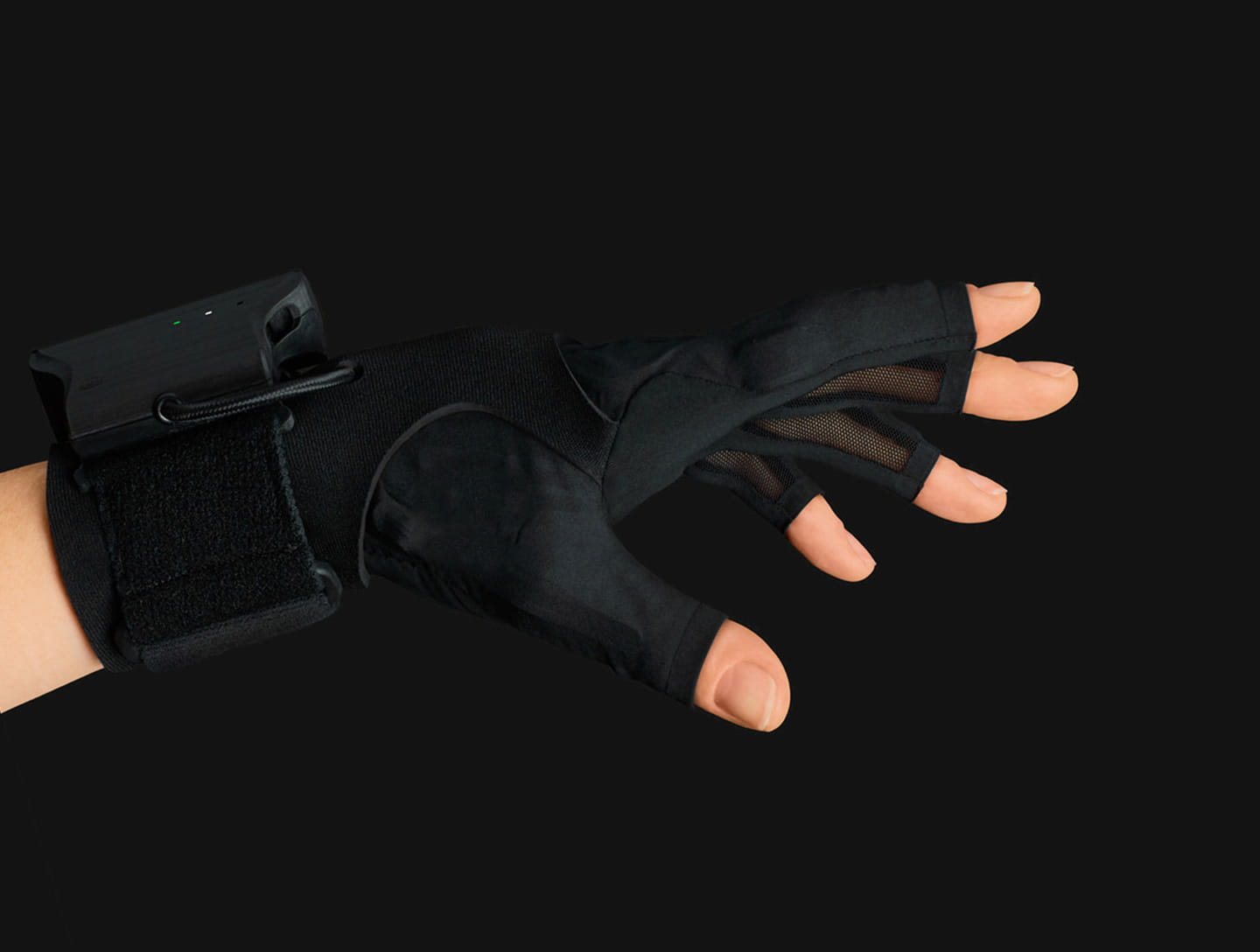
I first encountered this device while helping myself to the amazing work over at Kobakant’s How to get what you want site, a blog dedicated to open-source information on e-textiles.
The idea of a glove that captures gestures from your hands for creative output sounds fascinating at best, but after many years and research dollars, the commercial product, available at a grand total of SGD$4912, seems somewhat contrived, and to me, confusing to what it actually brings to the table.
First, let’s watch a video about what it can do:
Okay, that sounds kinda great. You can manipulate sound, play instruments and add effects in real-time. Yes, it does look snazzy and exudes a cool factor for the performer to use these trendy high-tech gloves for live performance.
But beyond that, I am not sure if I am missing the point of these gloves; if the gloves have to be manipulated in a specific way for the intended sounds to be created, then wouldn’t the ‘performative’ aspect of the performance be thus restricted to how the gloves can be used?
On one hand, the performer is freed from the keyboard, control surface or whatever else, yet the gloves rely on bending your fingers, twisting your wrist etc. for operation. From the examples shown, there doesn’t seem to be any significant difference to any aspect of the sound ‘produced’, which relies on the subtle finger bends or wrist twists.
The software, which is a separate purchase, seems to be trying to fulfil too many roles at once. Boosting support for Leapmotion, microbit(not sure why this is so other than this is a BBC product), iPhone and OSC, MiMu Glover interfaces with several devices and can act as a standalone performing application, with basic music mixing functionality that can be easily found in big names like Ableton.
From the video, it seems that a lot of calibration has to be done before any real music can be made. Each finger has to be assigned an instrument, and what the gestures do, and perhaps what range is desired for these parameters, so on and forth. Here, it starts to feel pretty similar to how a ‘traditional’ performer would approach his/her craft, setting up loops/patches and assigning it to keys and whatnot.
Perhaps I am too skeptical of technology for technology sake, but I cannot see the point of having something novelly hard to control, replace something that is straightforward, perhaps much more reliable, and not necessarily less sexy to look at.
One irony I detect when looking at the software was also that with the leap motion, one can basically have something that resembles the functionality of the gloves, albeit with some physical limitations. But at a modest price tag of a couple of hundred dollars(leapmotion) vs thousands, I don’t think it’s hard to make an informed choice.
In closing, somehow I have a feeling that the whole premise of the gloves’ extraordinariness is predicated on the fact that moving your hands to ‘control’ music while performing is considered ‘redefining’ how live performance is delivered(their words, not mine).
Pls check in your 3 motors. For non-ADM students pls approach me, I will do this for you.
The initial concept started out as a visualisation of data points, namely the increasing mean temperatures of different continents. As I tried to work with these cam shapes, I was unable to figure out a way to make it work with the followers. So the concept was adapted to portray an ‘underwater’ scene instead, with the cams driving the motions of elements like waves, fishing rods, lights and sea creatures.
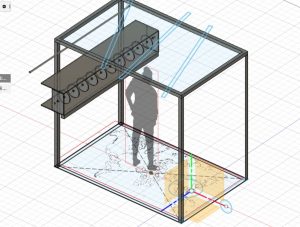
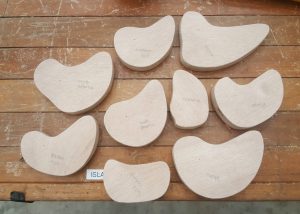
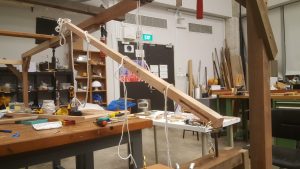
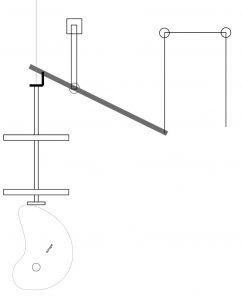

The waves are connected to both top and bottom mechanisms to amplify movement and create more variations
Initially there was the issue of not being able to work with the highly irregular cam shapes derived from data points. The follower rods also had to be tweaked to work with eccentric cams. It was a delicate dance to get the surfaces in contact right to work(sufficiently well). There was also a practical weight limit to how much the linkages could lift, as I found out during the last stages of attaching the waves. All in all, any one part that was added or subtracted tends to affect another part of the system in small or big ways. Extension springs were also good for stiffening parts as they allow for more leeway in terms of measurement.
As artists we are constantly looking for meaning to be attributed to our work, be it for commercial, social or personal causes. In the commercial space, I think the relationship between practice and product is clear and direct; work is created for a pre-agreed amount. Personal works are similar; it is done for one’s personal benefit and enjoyment, any additional benefits that come with it are complementary and mostly welcomed. Yet, in the social causes category, I think there is much more room for ambiguity and interpretation, manipulation and perhaps even (unfortunately) deception.
In an ideal society, problems are identified and solved progressively by people in power, with money and organisation. Therefore, in the un-ideal real world, many problems have to be solved in other, innovative and convoluted ways. And artists, being creative as we are, have discovered the potential of tapping on this attractive source of funding. It is the perfect marriage between ‘helping’ well-endowed individuals/organisations spend their money meaningfully and achieving a higher purpose in individual self-actualisation. In essence, it is similar to many other mechanisms in seemingly disparate fields; exploratory scientific research, nature conservation or humanitarian work etc.
All is well, but there is sometime uneasy about artists being engaged in social issues. Are we, as artists, privileged in our own way, have a sufficient level of understanding of such multifaceted complex issues to be able to address and propose appropriate solutions? Inherently, there is also a conflict of interest whenever there is monetary exchange involved; how much of the resources are actually spent on the social cause being addressed.
I would also argue that tackling social issues through artistic points of view could prove to be detrimental in some cases. Many social issues are exactly what they are; social in nature. As such, solutions can be simple and direct; sometimes people just need help, right there and then, till they get back on their feet, some never do. Introducing another element into the process could perhaps over-complicate/obfuscate the real issue, unnecessary diversion of funds notwithstanding. I do recognise the need for people to be compensated for their efforts in organising such efforts, but the real question is perhaps what constitutes a fair amount, and what qualifications/experiences are prerequisites, if any.
Having to lower one’s rhetoric in order to please donors, mopping up the symptoms of social problems instead of going after the disease itself, and, ultimately, reducing the vital work of political organizing to a symbolic gesture
I think this excerpt sums up quite nicely my thoughts on the issue. My gripe with artists trying too hard to ‘organise’ social causes is that the effort could easily be consumed eventually by something else altogether. With that said, I think this approach is a complex and possibly viable option going forward, but is easily subjected to abuse. Unfortunately I do not have a sound proposal for what could work, but I do believe that in today’s increasingly interconnected societies, misinformation, misdirection and misrepresentation are some of our civilisation’s most pressing problems. Competition, scarcity and consumerism have placed us on a relentless pursuit of intangible heights. Therefore, I feel social causes should remain as ‘pure’ as it possibly can in logistical and philosophical terms. Art can be employed in a complementary way, but not as a way to ‘sell’ the idea to attract funding.
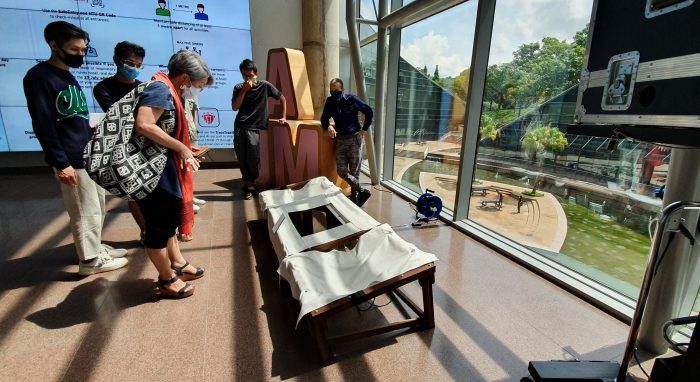
First off, all credit to kobakant, for their amazing work. Superb repository! I am not going to talk about how this thing works, because I didn’t invent it, and also they do it much better. Hard-soft connections can be found here.
Cooking Ingredients:
So to make a big mat for the final seat, of course it would be prudent to make small ones, like 3 times smaller to be exact. Some quick sewing and soldering and we are off to the races, with the WRONG material. I was just trying to be cheapskate and resourceful at the same time; used some ‘RF’ shielding material. From the test below, clearly it didn’t work. It was basically a big fat switch.
Ordered some velostat, and yes! It works.. kinda. Now just have to scale it up accordingly.
First design, I am just going with the flow and trying my best to construct a logical design. The wires come together at the end for a soft-hard transition, for easy wire connection.
Important to keep the threads straight and hot-gluing them to keep in position. Also, don’t forget to always leave the extra lengths of threads on until AFTER you hot glue everything. Only trim when the hot glue is set, duh…
Obviously, this wasn’t the first full piece I made. In fact, the third. Few things I picked up. The conductive thread shouldn’t be too thick; makes it hard to do everything. Ideally 2-ply would do. And always leave plenty of thread at the end for easy soft-to-hard sewing. Experimenting with 2-3mm stitch spacing, I felt that 2mm gives a neater result, and doesn’t really use much more thread; not sure about thread usage actually 🙂 .. Also, I made the terminals face same direction for both pieces, for obvious reasons …
Yes, hot glue does solve everything in this case. I really don’t think it’s possible to make a reliable product if you choose this type of connection.
To ‘attach’ all three pieces together, I decided against stitching as I wanted to make the pieces as serviceable as possible. So I used buttons instead. This way I can simply button the sensor onto the chair seat.
Positioning by eyeball, I am guessing most people will sit at the bottom 1/3 of the seat, and also because my sensor is only 27 x 27cm; due to the size of velostat I could procure. But I figured technically I could cut out strips of velostat and sew them onto the stitching, so I could increase the mileage of the velostat use. I’m playing it safe though as time was tight.
Slits are required for the terminal ends to hang loosely so that nothing breaks when 100s of pounds are applied onto the sensor. Small strips of fabric are used to reinforce the sides of the slits in an opposing direction.
Sitting on it and not breaking anything was a sign of relief. Now I just need to go through the whole process and create the second piece.
Before I could test run, I had to solder lots of wires; nope, the crimped ones aren’t going to cut. I ran a count, and am proud to say that I did over 100s of soldered joints by the end of the project. But I still had to rely on hot glue 🙂
Here you can see it kinda works, it’s a little noisy and off in accuracy at certain parts. But otherwise I am glad that something even flashes..
As I am making another set, why not have some fun and experiment a little? So I decided to try out a new layout and see if I can notice any tangible difference. Here the layout is for maximizing wire spacing, so that I can delay the tiny spacing as long as possible, but it does burns your pockets…
Getting neat and tidy joints take time; 1-2 hrs on average!
Tying knots mean the thread length needs to be more, which equals extra cost. So being cheapskate me, I struggled with tying knots while having short ends. But I realized that you can get away by just having it loosely looped while pulling it through, but does require a finer touch.
Tie a knot! You can never tie too many knots when you are doing e-sewing.
I must say, this second set seems much improved. In appearance I mean.
Last stretch, the sensor is integrated and we are done
Simple makeshift board for mounting the megas, with tremendous cable management and strain relief.
But mine doesn’t. Touchdesigner is all the rage these days, and I have no intention of bucking the trend.
I try to modularise as much as I can so that the logic can be made/fixed independently, OOP style, so to speak.
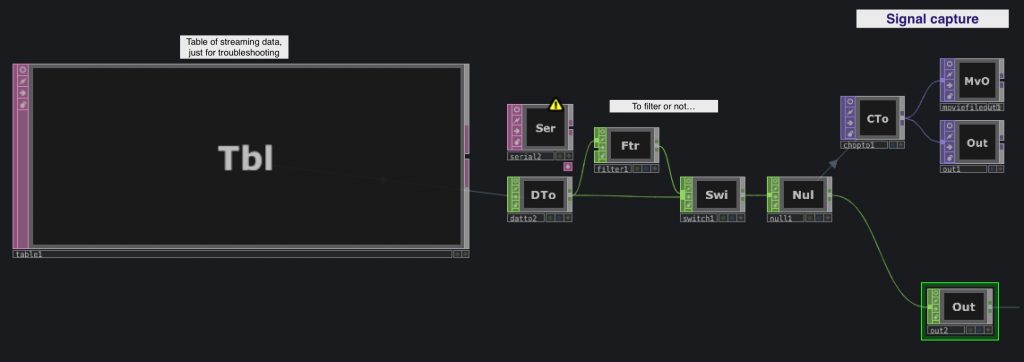 This module simply receives data from Arduino and converts it into a usable format. TD is receiving the serial data in rows, as I tried sending all 121 values all at once but doesn’t play well.
This module simply receives data from Arduino and converts it into a usable format. TD is receiving the serial data in rows, as I tried sending all 121 values all at once but doesn’t play well.
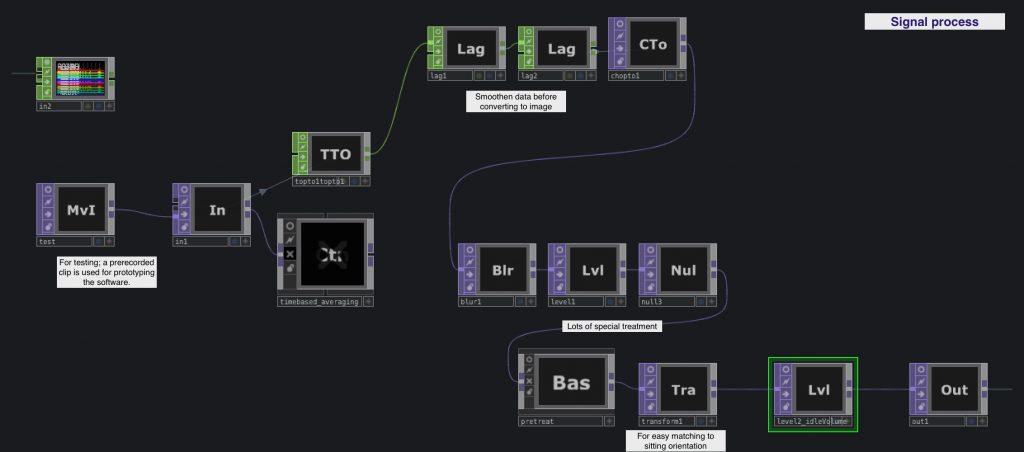 The data is pretty noisy, partly because I believe of the many imperfections of the homemade sensor, and also the lack of calibrated tests based on the conductive threads I used. In short, lots of data fixing before it’s in usable form.
The data is pretty noisy, partly because I believe of the many imperfections of the homemade sensor, and also the lack of calibrated tests based on the conductive threads I used. In short, lots of data fixing before it’s in usable form.
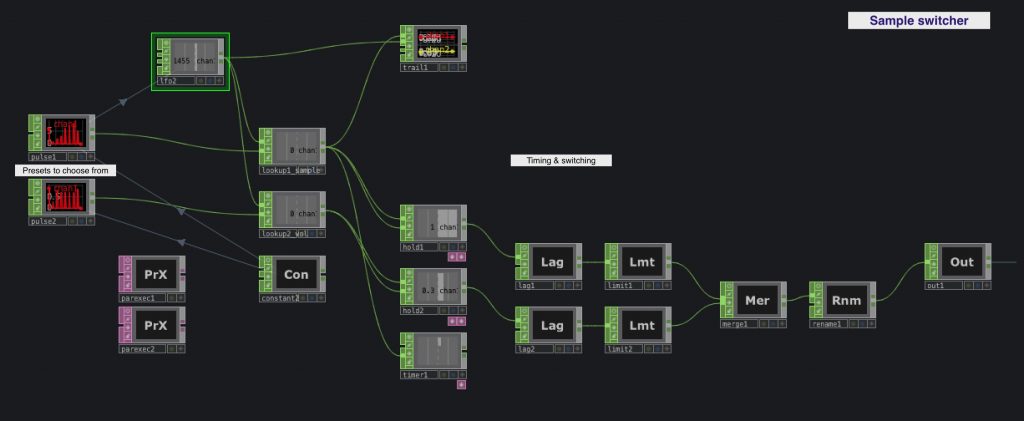 This part is simply to automate the process of changing instruments/sample combinations every set interval, so that I don’t have to pay someone to sit there and press a button. Also, I can experiment with combinations and add/remove them easily.
This part is simply to automate the process of changing instruments/sample combinations every set interval, so that I don’t have to pay someone to sit there and press a button. Also, I can experiment with combinations and add/remove them easily.
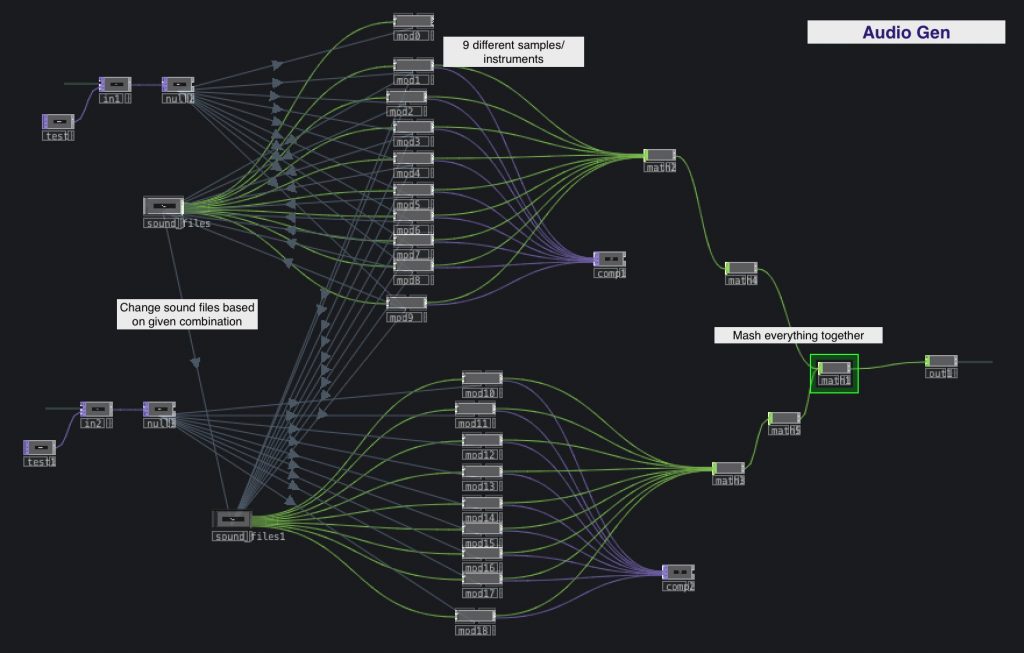 Many connections, but it’s because we are dealing with 2 chairs, and each chair’s sensor has 9 spots that correspond to 9 different sound files. TD makes it easy, and very fast as well.
Many connections, but it’s because we are dealing with 2 chairs, and each chair’s sensor has 9 spots that correspond to 9 different sound files. TD makes it easy, and very fast as well.
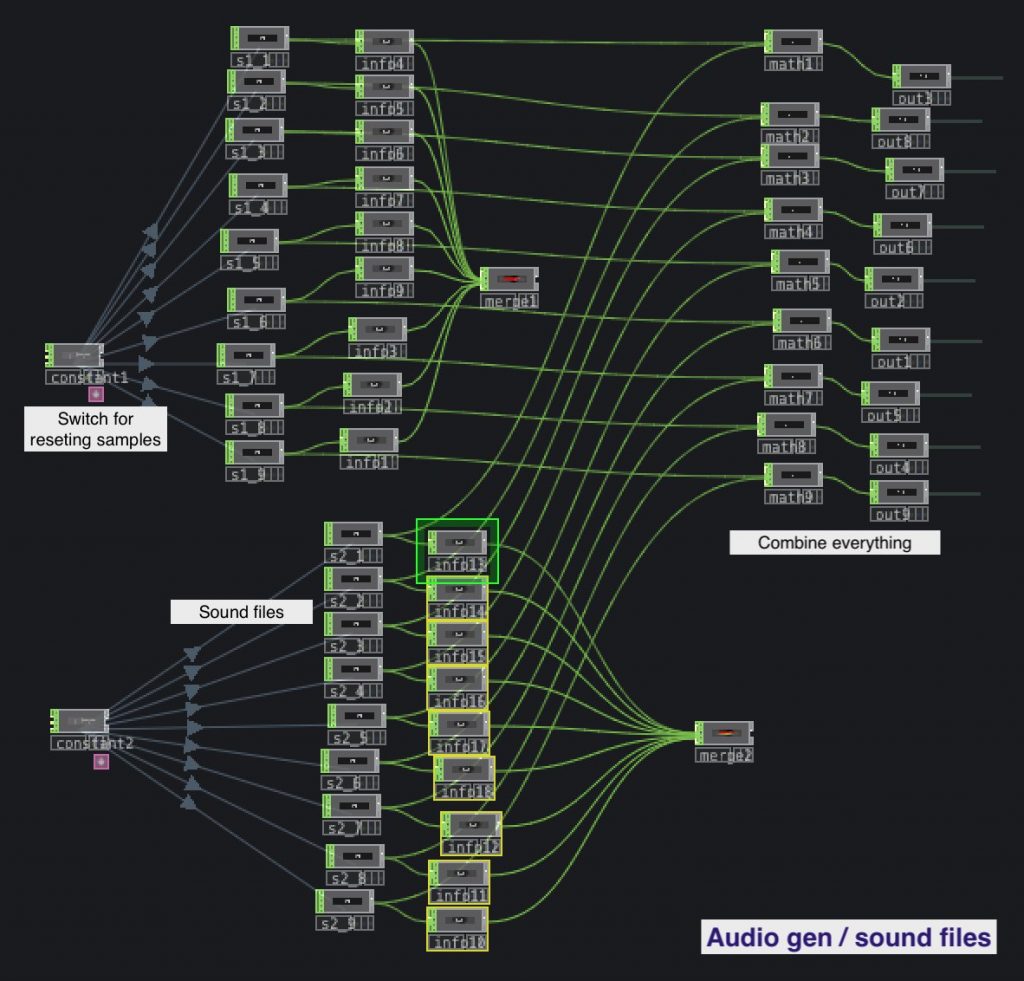 Here the sound files are switched out according to what combination is selected. Again, TD has made it easy; here I am switching between 9 sound files x 8 combinations = 72 files, all achieved with some dragging and dropping.
Here the sound files are switched out according to what combination is selected. Again, TD has made it easy; here I am switching between 9 sound files x 8 combinations = 72 files, all achieved with some dragging and dropping.
Here the outputs from the sensor visualisation are combined, and I have added a ‘watercolor fx’ just for added visual interest. and partly because the iMac has enough muscle to run everything at 60fps.
The day has come for showcase !
Special mention(again):
Sensor Fabric based on work & research by Kobakant
Special thanks to:
Relational architecture, is an interesting concept. I interpret it as re-making the architecture, from a cold, emotionless structure, to one that allows and facilitates connection between people. From Rafael’s Relational Architecture series, one can experience new ways in which structure drives communication/connection, bring people together, help people relate to each other, or simply bridging the gap between strangers.
Here are three other pieces, other than the ones mentioned in the article, that I felt have achieved the feat of transforming architecture into a wondrous medium, almost imbuing it with organic, life-like qualities at times.
Border Tuner / Sintonizador Fronterizo, 2019
Players at six different sites use a beam of light to ‘connect’ with one another. When the powerful light beams intersect each other, players can communicate with each other using the provided microphone.
Strangers, prompted by this magical mechanism of light beams connecting across the sky, connect and speak to someone miles away.

Players at the station can feel another player’s pulse at another station when he/she places his/her palms on a provided hand interface.
The transfer of something as human as a pulse elicits a sense of connection, between strangers, without need for words, sound or visuals.
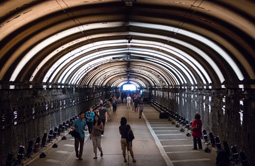
A tunnel, filled with lights, is controlled by voice recordings of participants who speak into a special intercom in the middle of the tunnel. As new people participate, old recordings get pushed away down the array of lights. The “memory” of the installation is always getting recycled, with oldest recordings on the tunnel edge and newest in the middle.
This tunnel represents time, time in which people have come and passed, similar to how people come and go, shaping the world around them as they pass along. The metaphor of voice recordings represent the unique individuality in everyone of us, and the light intensities provide a visual metaphor for the liveliness of the individuals that have participated in the tunnel.
Int space
Idea 1 – listening with intent
Idea 2 – trust, communication without words
Idea 3 – instead of relying on visual for memory tasks, rely on touch

Better Future Factory is a sustainable product design studio specialised in innovative solutions for plastic recycling – Better Future Factory mission statement
There is an urgent need to start addressing sustainability issues moving forward. That said, projects that encourage contemplation and propose novel solutions are few and far between. There are two projects that I would like to highlight from this incredible studio.
As an idea it is simple and straightforward. Our actions have a direct impact on the planet, and we need to start taking responsibility for them. The silhouette of the participant is captured as he/she stands in front of the pool of black water. This is visualised using all manner of sorts of plastic trash that were sourced from plastic islands around the planet.
The visual design of the installation is minimal, effective and poetic all at once. The clever use of black water serves both technical and artistic purposes. It hides the plastic objects as they submerge below the water surface, and black water subconsciously evokes a sombre and reflective mood. Coincidentally the participant is able to catch a glimpse of his/her own reflection in the water, providing a quick reminder that every individual has a role to play.
Needless to say, the technical accomplishments are impressive. The mechanics are simple in nature, but well executed and completely invisible to the audience, a hallmark of exceptional work.
As the participant walks away from the installation, the re-submerging of the plastic objects results in a pool of clear black water. This is a reminder to the audience that irresponsible actions will lead to an undesirable outcome for generations to come.
On a side note, as an additional touch, an enclosed layer of clear water can be positioned on top of the black water layer, and shown when the installation is in ‘idle’ mode. The clear water can be ‘flushed’ in/out via the sides on demand.
The above experiential installation is a great example of how message can be delivered through experience.
The installation was first introduced in a park, where the young and old get to learn more about the recycling process while having a little bit of fun, as well as bring something home.
The end product might be considered trivial, but the impact is real. Participants get to see first-hand the possibilities of recycling plastic. Humans are highly visual creatures, so it helps to be able to ‘see’ the possibility in a very tangible way. And being able to bring away a keepsake can serve as a constant reminder; long after we return to our fast-paced, consumerist lives.
On another level, makers, innovators and change-makers will be inspired. If a recycling process can be achieved via an installation as shown, with minimal facilities and manpower, imagine the possibility of small localised and organised efforts.
After many years of inaction, it is evident that we as global citizens, have to organise at the grassroots’ level to effect positive change. Governments and corporations are not going to magically start placing their other priorities below the climate change issue for the foreseeable future. This installation can serve as one of the many first steps we can take to start a responsible, sensible cycle of producing, consuming and recycling; to ensure there is a better tomorrow ahead.
Better Future Factory
Plastic Reflectic
Landal educative installation